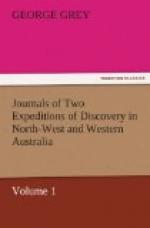Tenerife. Aqueduct at Santa Cruz.
The usual incidents of a sea voyage brought us to Santa Cruz in Tenerife, where I landed on Wednesday 19th July 1837, about 2 o’clock in the afternoon. There was a sort of table d’hote at 3 o’clock at an hotel kept by an Englishman, at which I dined, and was fortunate in so doing as I met there a German and several English merchants who were principally engaged in the trade of the country. There was also a gentleman who had been from his earliest years in the African trade for gums, etc.; and he gave me many interesting particulars of the wild life the individuals so occupied are compelled to lead. In the afternoon I made a set of magnetic observations and then walked out to see the aqueduct; which at about three-quarters of a mile to the north-east of the town approaches it by a passage cut through a mountain. The execution of this work must have been attended with immense labour, for, although the design is grand and noble, the actual plan upon which it has been completed was by no means well conceived. The average depth of this cut is at least one hundred and twenty feet, its length is about one hundred and eighty, whilst its breadth in many parts is not more than four.
Previously to the construction of this aqueduct the town of Santa Cruz was very badly supplied with water, indeed so much so that the inhabitants were, at some periods of the year, compelled to send upwards of three miles for it; but no want of this nature has ever been experienced since its completion. The expenses of its construction as also of keeping it in repair are principally defrayed by a tax upon all wine and spirits actually consumed in the town.
The scenery of the country I walked through was bold and romantic but by no means rich; fig-trees grew wild about the mountains, and it seemed singular that, whenever I approached one, the peasants on the adjacent hills shouted out in loud tones. As far as I could understand the guide, this was done to deter us from eating the fruits now just ripe, and, upon my return to the town and making further enquiries, I found that such was their custom.
Excursion to Oratava.
July 20th.
I started at six o’clock with Mr. Lushington for Oratava, distant about 30 miles from Santa Cruz. We were mounted on small ponies, admirably adapted to the wretched roads of the country, and accompanied by two guides who carried our carpet bags.
Camels, Matanzas, the Guanches.
The first town we came to was Laguna, which appeared to be of some importance; it is distant about four miles from Santa Cruz. On this road we passed many camels laden with heavy burdens; a circumstance which rather surprised me for I had always imagined that, owing to the peculiar formation of its foot, the camel was only fitted for travelling over sandy ground, whilst the way from Santa Cruz to Laguna is one continued mass of sharp rocks, utterly unworthy of the name of a road; yet these animals appeared to move over it without the least inconvenience.




